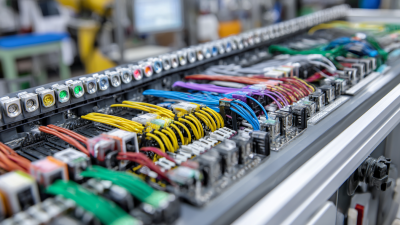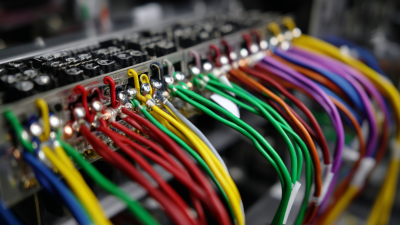Challenges Faced in Cable Harness Design Efficiency
In the ever-evolving landscape of electrical engineering, the efficiency of cable harness design stands as a pivotal factor influencing the overall performance and reliability of various systems. However, as the demand for more complex and integrated solutions grows, designers face a myriad of challenges that can impede the optimization of these vital components. From the intricacies of material selection to the need for precise specifications and effective communication among teams, the obstacles in cable harness design are multifaceted.

As industry professionals strive to enhance productivity while minimizing costs, understanding these challenges becomes essential for fostering innovation and achieving robust, efficient designs. This blog explores the various problems associated with cable harness design and offers insights into strategies for overcoming them, ultimately aiming to streamline the design process and improve end-product quality.
Understanding the Importance of Cable Harness Design Efficiency
Cable harness design efficiency is crucial in various industries, particularly in automotive, aerospace, and electronics. A well-designed cable harness not only ensures seamless integration of electrical systems but also enhances overall product reliability. Effective design practices can significantly reduce manufacturing costs and time, which is vital in today’s competitive market.
Understanding the importance of cable harness design efficiency involves recognizing the balance between functionality and manufacturability. Designers must prioritize the layout of wires and connectors while considering factors such as space optimization and ease of installation. Efficient designs minimize bulk, safeguard against electromagnetic interference, and provide sufficient protection against environmental elements. Moreover, incorporating modular components can enhance flexibility for future upgrades or modifications, ultimately benefiting both the manufacturer and the end-user.
By focusing on these design efficiencies, companies can improve the performance and longevity of their products, while simultaneously addressing the growing demand for innovation and sustainability in their processes. Emphasizing design efficiency from the outset can lead to more robust, reliable, and cost-effective solutions.
Challenges Faced in Cable Harness Design Efficiency
| Challenge | Impact on Efficiency | Solutions | Importance |
|---|---|---|---|
| Complex Geometry | Increases design time and errors | Utilize CAD software | High |
| Material Selection | Affects weight and cost | Conduct material analysis | Medium |
| Regulatory Compliance | Delays in approval processes | Early planning and documentation | High |
| Testing and Validation | Long project timelines | Implement automated testing | High |
| Supplier Coordination | Potential supply chain disruptions | Establish strong supplier relationships | Medium |
Common Challenges in Cable Harness Design
In the realm of cable harness design, engineers frequently encounter a myriad of challenges that can hinder efficiency and lead to increased production costs. One prominent issue is the complexity of modern electrical systems. According to a report by MarketsandMarkets, the global market for wire harnesses is projected to reach $61.4 billion by 2026, driven by advancements in automotive and aerospace industries. This growing demand translates to intricate designs that require meticulous attention to detail. The intricacies inherent in managing multiple wires, connectors, and components can lead to design errors if not addressed effectively.
Another challenge is the lack of standardization across industries. Each sector often has its unique specifications, making it arduous to create universal designs. A study published by the International Journal of Advanced Manufacturing Technology highlights that up to 30% of design time could be wasted due to non-standard components and practices. These inefficiencies can result not only in longer lead times but also in increased costs associated with rework and testing procedures. Streamlining design processes through better collaboration and standardized practices is crucial for overcoming these hurdles, enabling companies to meet the growing market demands without sacrificing quality.
Challenges Faced in Cable Harness Design Efficiency
This chart illustrates the common challenges faced in cable harness design efficiency, highlighting the primary issues that engineers encounter during the design process.
Best Practices for Enhancing Design Efficiency in Cable Harnesses
In the realm of cable harness design, inefficiencies can lead to significant delays and increased costs. According to a study by the International Wire & Cable Symposium, 35% of design teams report that lengthy iteration times directly impact their project schedules. To combat this issue, adopting industry best practices can be highly beneficial. One such approach is the early adoption of standardized design templates. This not only streamlines the initial phases of the design process but also minimizes errors that often arise during custom fabrication.
Moreover, leveraging advanced software tools like Computer-Aided Design (CAD) and 3D modeling significantly enhances design efficiency. A report from the Association for Manufacturing Technology highlights that using these technologies can reduce design time by up to 40%. Additionally, incorporating design-for-manufacturability principles encourages collaboration between engineering and manufacturing teams, allowing for seamless transition from design to production. Effective communication and feedback loops are vital, as they can decrease the risk of costly modifications later in the process, ultimately leading to shorter lead times and improved profitability for the organization.

The Role of Technology in Streamlining Cable Harness Development
In today's fast-paced technological landscape, enhancing the efficiency of cable harness design is crucial. The growing complexity of wiring systems necessitates innovative solutions that can streamline development processes. Recent industry reports indicate that cable harness manufacturing can consume up to 30% of the total production cost in the automotive sector alone. Harnessing advanced technologies, such as 3D modeling software and automation tools, can lead to significant cost reductions and improved design accuracy.
One effective approach to improving cable harness development is through the implementation of Digital Twin technology, which allows engineers to create a virtual representation of a physical cable harness. This method helps in identifying potential issues early in the design phase, thereby reducing costly redesigns. According to a report by Markets and Markets, the digital twin market in Europe is projected to grow by 38% annually, indicating a strong trend towards data-driven design methodologies.
Tips: Utilize software that supports parametric design to speed up modifications and adapt to changes quickly. Additionally, consider integrating project management tools that facilitate real-time collaboration among engineering teams. This not only ensures a synchronized workflow but also reduces delays associated with communication gaps.
Mitigating Risks in Cable Harness Design Through Effective Planning
Effective planning plays a critical role in mitigating risks associated with cable harness design, an area where inefficiencies can lead to expensive delays and increased production costs. According to a recent report by the National Institute of Standards and Technology (NIST), poor design practices can result in rework costs escalating by as much as 20-30% of the total project budget. Therefore, embracing a comprehensive design strategy not only enhances efficiency but also aligns project timelines and budgets with stakeholder expectations.
Additionally, leveraging advanced simulation tools during the design phase can significantly reduce the likelihood of costly errors. Research from the Institute of Electrical and Electronics Engineers (IEEE) indicates that design errors are responsible for approximately 60% of the time lost in cable harness development. By integrating tools that facilitate real-time adjustments and visualization, teams can proactively identify potential issues, allowing for prompt resolutions and minimizing disruptions in the production workflow. Implementing these best practices is essential for driving efficiency and fostering innovation within the cable harness industry.



